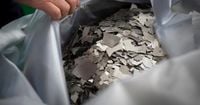In the midst of escalating trade tensions between the United States and China, the strategic importance of rare earth minerals has come to the forefront, highlighting a complex web of dependency and geopolitical maneuvering. As of April 2025, the U.S. has strategically exempted 31 types of vital minerals, including rare earth elements, from tariffs. This exemption is not merely a gesture of goodwill; it underscores the United States' deep reliance on China for essential materials critical to technological competitiveness, clean energy transition, and national defense.
China's response to these developments has been swift and calculated. The Ministry of Commerce in Beijing announced an expansion of export controls and a shift in pricing principles for rare earth elements. This move reflects China's long-standing effort to transition the pricing of rare earths from market-based to value-based, emphasizing their strategic importance. The immediate impact has been significant, with export activities of rare earths from China experiencing delays as exporters navigate new licensing requirements.
In light of these developments, former President Donald Trump issued an executive order aimed at reviewing national security risks stemming from U.S. dependence on processed and imported critical minerals. The global supply chain is already feeling the strain, and Australia finds itself in a unique strategic position. As a reliable ally of the U.S., Canberra possesses the resources, partnerships, and political capital to potentially capitalize on this situation. However, questions remain about whether Australia can effectively seize this opportunity without being burdened by restrictive conditions.
China's latest restrictions specifically target seven types of rare earths that are crucial for electric vehicles, wind turbines, fighter jets, and missile systems. While not a complete ban on exports, these policies create significant bottlenecks. China currently dominates nearly 90% of the global rare earth refining market and holds a staggering 98% of heavy rare earth processing. In contrast, the U.S. has only one operational rare earth mine—Mountain Pass in California—and its domestic refining capacity is minimal.
Adding to the complexity, Europe faces similar challenges with its limited domestic production of rare earths. Despite the critical role these minerals play in the EU's green transition, production remains constrained. Efforts to diversify supply sources through partnerships with Australia and Canada show promise but are hindered by high production costs and ongoing reliance on Chinese technology.
China is also attempting to redefine how rare earths are valued. Proposals have been made to tie the value of key elements like dysprosium to gold prices, elevating them from mere industrial inputs to geopolitical assets. Additionally, there are suggestions to conduct rare earth transactions in yuan instead of U.S. dollars, furthering Beijing's ambition to internationalize its currency.
For Australia, strategic mines like Mt Weld in Western Australia have attracted renewed interest from Japan, Europe, and the U.S. Observers in the industry believe that Australia is better positioned than the U.S. to develop a secure supply chain, thanks to its rich geological resources and transparent regulatory environment. To capitalize on this opportunity, the Australian government has begun to take action. Under the Future Made in Australia initiative, it is considering measures such as strategic reserves, production tax credits, and expanded support for domestic processing.
Iluka Resources has secured AUD 1.65 billion (USD 1.05 billion) to construct a rare earth refinery, which is expected to be operational by 2026. New projects like Browns Range and Lynas' refinery in Malaysia are emerging as alternative nodes in the global rare earth supply chain. However, structural barriers remain. Western allies, including Australia, continue to lack critical processing technologies and may face high compliance costs related to environmental regulations.
The geopolitical landscape complicates matters further. Australia's dual role as a major upstream supplier to China and a strategic ally of the U.S. places it in a precarious diplomatic position. If Australia leans too heavily towards the U.S., it risks facing retaliation from China; conversely, a too-friendly stance towards Beijing could invite scrutiny from Washington.
Concerns over ownership are also escalating. The Australian government has blocked or compelled Chinese companies to divest from several rare earth and lithium firms, including Northern Minerals. Market volatility exacerbates these challenges, with prices currently driven up by geopolitical risks but remaining highly unpredictable. Moreover, China's ability to undercut global prices could undermine the competitiveness of Australian exports.
Rare earths have become a contentious issue in the ongoing trade war. Australia stands at a strategic inflection point, poised to benefit from China's retreat yet vulnerable to the intensifying competition among great powers. In a world where resources equate to influence, the pressing question for Australia is not just whether it has sufficient mineral reserves, but whether it possesses the right strategy to leverage them.
If the government can seize the current opportunity—by diversifying partnerships, investing in production capacity, and skillfully managing relations with both allies and rivals—Australia could emerge as a leading player in the new landscape of strategic minerals. In this era of geopolitical resource competition, merely possessing minerals is not enough; the real challenge lies in whether Australia has the vision and determination to lead the way.





